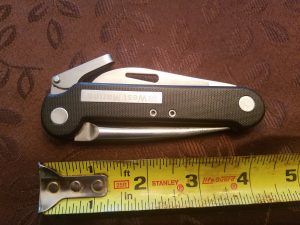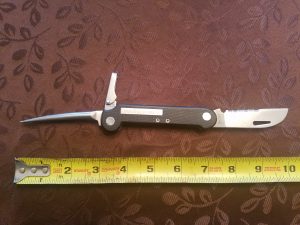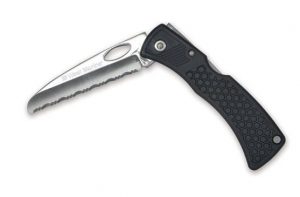I’ve only been sailing for about 20 percent of my life. Not much when you think about it. I was actually a late comer into the sport. However, one thing I have learned is the importance of having a knife available within easy reach. I think the most important lesson I’ve learned is that when you need a knife, you need it now, not a “let me get a knife from below” amount of time, but now … and lives may depend on it. In one case that comes immediately to mind, somehow a line got wrapped around someones upper leg. No one really knows how. Unfortunately that line was under a lot of pressure, and the leg was at risk. Some quick work cutting the line with an available knife relieved the pressure, but not before enough damage was done to a blood vessel in the leg that surgery was required. I can only imagine what might have happened after a minute or two of pressure. Enough of the scare tactics. Its time to move on to what I believe makes a good knife.
Much of this tip is my own personal opinion, however, based on the research into the topic I have conducted, it’s supported by most of the experts in the sailing community.
I never step on a boat without at least one knife on my person. Generally, two or three of them. Why? Because there is no such thing as the perfect all round knife good for everything. The knife that is perfect for safety cutting a line on a pitching deck is going to be less than perfect at removing that same line from around a propeller shaft, and will fail dismally at cleaning that fish you just caught for dinner or for buttering your bread for dinner (I know, not an emergency, and you have time to look for a better option.)
There are two basic types of knives. Folding knives and fixed blade knives. Everyone has there own opinion of which is best. For a variety of reasons, folding knives are the more popular. Not necessarily better, but more popular. For example, 4 inch blade on a folding knife fits in a 4 1/2 inch package. 4 inches on a fixed blade comes with a 4 inch handle, nearly doubling it size. On the other hand, a 4 inch fixed blade worn on the hip can be deployed in a matter of a second or two using either hand, whereas a folding blade knife generally needs to be fished from a pocket and then opened, often requiring two hands. Once you have decided on folding vs. fixed, the following features can be found in both varieties.
- Get a 3 or 4 inch bladed knife.
- Except in the case of cleaning a fish, a sailors knife should never have a sharp point. Blunt, rounded or even squared off points are best. Even the thought of a pointy knife on a boat scares me. If you have ever lost your balance on a pitching boat and fallen into the person next to you, you can understand why.
- A knife used to cut today’s modern lines pretty much needs to have a serrated blade. A smooth blade, no matter how sharp, tends to slide back and forth on the line instead of cutting through it. Many knives try to get the benefits of a serrated edged and a smooth edged blade by making it half of each. Its a compromise and never really works as well for either set of circumstances as it might.
- It should be heavy duty. A light knife has it’s place, but a sailors knife needs to do heavy work during times that breakage is not an option.
- There should be a hole in the end, or a built in shackle, to attach a lanyard. If you drop it, you don’t want it to go far.
- A handle that won’t slip and is hefty enough not twist in your hand in use.
- Stainless steel. For two reasons. It doesn’t rust as readily, and, it isn’t magnetic. Rust is pretty self explanatory, but why non-magnetic? I still laugh when I think of the class I was teaching how to take a bearing with a “hockey puck” style compass. I could not get the same reading as anybody else, by about 10 degrees. Turns out the new knife in my PFD pocket was not as stainless as I thought and was deflecting the compass needle. Last time I used that knife.
- A blade that locks securely in place. I still have the scar I got in the 7th grade when a knife folded up on me while I was using it.
- This final item is not really a feature, more of a fact. It must be maintained well, and kept sharp. I believe a dull knife is more dangerous than a sharp one. One of the other instructors needed to cut a line one day and I was handy with my knife. He was braced for a hard pull to get the knife through the line and was shocked when it cut as easily as it did. His response “Wow … you could have warned me it was that sharp”. Here is your warning. My knife is sharp.
My own personal choices in sailing knives. I always have two on me. Even though I personally feel a fixed blade knife is better, both knives I carry are folding. The one in my outside pants pocket is shown below, both open and closed. As you can see it includes a blade and a fid, as well as a tool to help open shackles. If you look closely, the blade is only serrated about half its length, which makes it less than optimal for cutting line,
which is why the second knife I always carry, secured to my PFD by a lanyard, is a light weight, folding, knife with a 4 inch blade that is serrated it’s entire length, and only used to cut line. I couldn’t show a picture of the actually knife because it never leaves the pocket of my PFD, which is currently on my boat and I’m not, however this is a photo of the same type taken from the West Marine website.
So why don’t I carry that fixed blade knife I was saying I prefer? Legalities. I’ve said it before, and will probably say it again. I’m not an attorney, just a sailor, so please do not construe this as legal advice. If you want legal advice, talk to an expert. With that said, there are exceptions, however, generally it is lawful in the State of California to have a folding blade knife in your pocket. A fixed blade knife, regardless of the size, is NOT legal in the State of California if it is concealed in any way. It then meets the definition of a concealed dirk or dagger and is considered by law enforcement to be a felony. An acquaintance of mine had a knife custom made for herself. A fixed blade knife designed to be worn in a sheath hanging around the neck. I’ve seen it. It is beautiful. In my opinion, the perfect sailors knife. All of the good features I listed aboved, except that it hangs around the neck, and anything hanging around a sailors neck is one jib sheet away from becoming a noose. To use the knife safety, she wears it under her PFD, thereby controlling it, and unfortunately, concealing it. In her case, it’s not a problem. She lives and sails in a different state that doesn’t have the same laws. For her, it’s the perfect knife. For me, I don’t want to take a chance on accidentally covering it up with my PFD or my foul weather gear and running into a problem. So, as a compromise, I stick with folding blades and carry two of them. Always ready in the event of an emergency.




This is excellent, thank you Don! On the online forums, serrated vs. not is a neverending debate. Your arguments settle the matter for me.
A couple questions for you:
1. Do you have a lanyard attached at all times? Or just as needed? Because I could see the desire to keep it from falling far conflicting with an urgent mobility need, say, cutting one’s tether if necessary, which would require a maybe 2 foot lanyard.
2. How can a serrated blade be kept sharp? Do you have a trick? Or does it just have to be replaced after so many uses?
Hi Chuck … great questions
Yes, typically I have the lanyard attached at all times. The example you used of cutting a tether is a perfect example of why. If you are in a position you need to cut a tether, you probably don’t have an extra hand available to retrieve and attach it. Personally, I like a lanyard that is 24 to 30 inches long. I keep the bitter end attached to a strap or in a pocket on my PFD. Make sure to roll up the length of the lanyard and tuck it away. You don’t want it to get caught in something the you don’t want it to get caught it (like a winch).
The good news is, serrated blades stay sharp longer. The bad news, they are more challenging to renew the edge when they get dull. There are special sharpening tools made to sharpen serrated edges. Usually, it consists of a tapered rod with an abrasive surface and a handle. The best article I have found to explain the process in easy to understand language is on wiki-how.
https://www.wikihow.com/Sharpen-Serrated-Knives
Excellent, thank you again!